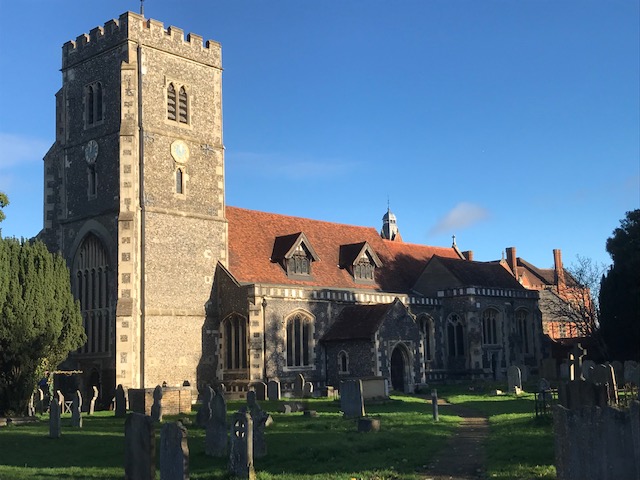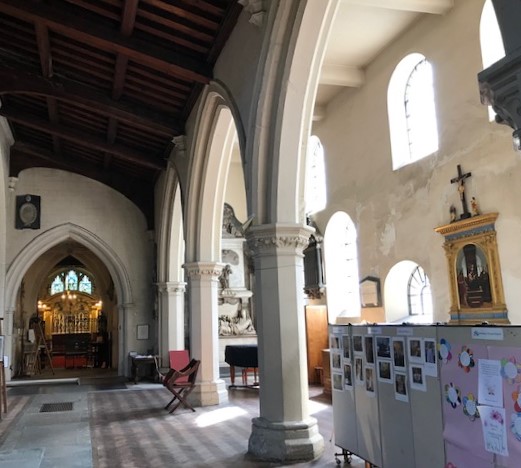Rivers have always been magnets for human activity: barriers, highways, sources of water, food, energy, and plants with a thousand uses. Hence the endless busyness, going back millennia, in the landscape around Beddington, just west of Croydon on the River Wandle.
Over the years archaeologists have found traces of Bronze Age ditches; a Roman villa under the sewage works to the north of the river; a Roman lead coffin found on the south side which is now housed in the church; and Anglo-Saxon cemeteries on both sides of the river, with a tenth-century coin of King Aethelstan to the north, and burials to the south which date back another four or five hundred years, to the first period of Germanic settlement.
The place-name may derive from the Old English ‘bedd’ meaning, predictably, a bed. This led in the past to antiquarian speculation that the original village offered accommodation for travellers on Stane Street, the old Roman road, which was believed to pass close by. This notion of an Anglo-Saxon hotel or coaching-inn is beguiling, but unlikely, because Stane Street was not close by. Its nearest approach was at Cheam, about four miles to the west. The Roman road to Brighton was closer, though even that was about two miles away as it passed through Croydon Old Town.
Whether or not it could boast an hotel, we know that Anglo-Saxon Beddington had a church, which is recorded in the Domesday Book. A hundred years ago the Reverend Thomas Bentham argued that this church must have been standing by the late ninth century because Aethelwold, Bishop of Winchester, died at Beddington in 894. Bentham thought that a bishop was unlikely to visit a village unless it had a church, so there must have been a church at Beddington at the time of his visit, during which he unfortunately died. I’m not convinced. This argument seems to me to assume that the church in Saxon Wessex a thousand years ago, at a time of recent war against the Danes followed by an armed truce, operated along similar lines to the suburban Anglicanism of the 1920s, with gracious episcopal visitations to diocesan churches. I do not believe that we can fix the date of Beddington’s Saxon church any more precisely than to say that it must have existed by the late eleventh century in order to be recorded in Domesday.
However, it is generally accepted that this Domesday church was on the same site as the present church, just south of the Wandle. The present church is described pithily in Pevsner’s 1960s guide to Surrey as “Perp throughout”. This is not quite true: its style is very largely Perpendicular, but it is also significantly Victorian, each reflecting a moment of rebuilding and renovation, one orchestrated by local lord Sir Nicholas Carew in the late fourteenth century, and the other by local priest Canon Alexander Bridges in the nineteenth. Both men were wealthy, and it shows; St. Mary’s is unusually large and impressive for the size of the parish which it serves.
The Perpendicular style is best known for its large windows with shallow pointed arches, with stone mullions and metal tracery often containing panes of stained glass. The confidence, the audacity, to construct such windows derived from a sophisticated appreciation of the load-bearing capacities of the pointed arch, and its ability to direct and manage great downward stress even when the wall beneath consisted largely of glass.
Carew’s project was ambitious, but he was not starting from scratch. He was essentially re-modelling a Norman church which in his day was already about two hundred years old. Just as nothing remains of the original Saxon church, so little survives of this Norman successor – except the font, squat and solid on its sturdy pillars, harking back defiantly to an era before pointed arches and painted glass.
Canon Bridges’ nineteenth century work was mainly, and predictably, inspired by romantic medievalism. I say this not as criticism, but in affectionate appreciation. For instance, the extensive Victorian painting on walls and pillars and ceiling on and beyond the chancel arch is wonderful, rich in colour and detail. We cannot know if this is how the original medieval church looked, but this is surely how it ought to have looked.
To conclude: the first church at Beddington was built in Anglo-Saxon times, recorded in the Domesday Book, and stood on the south bank of the River Wandle in a landscape which had been settled for thousands of years. It was close to the sites of one or more pre-Christian cemeteries. No physical fabric from this Saxon church survives, but the present-day church is in the same place, and to that extent bears witness to it, and to the continuity of a human presence in this place.
SOURCES
John Addy (1874), ‘Account of a Roman villa lately discovered at Beddington, Surrey’, Surrey Archaeological Collections, vol. 6.
Anon (1792), The Environs of London, T. Cadell and W. Davies, London.
Rev. Thomas Bentham (1923), A History of Beddington, John Murray, London.
John Wickham Flower (1874), ‘Notices of an Anglo-Saxon cemetery at Beddington, Surrey’, Surrey Archaeological Collections, vol. 6.
H,E. Malden (ed.) (1912), A History of the County of Surrey vol. 4, Victoria County History, London.
Ian Nairn & Nikolaus Pevsner (1962), The Buildings of England: Surrey, Penguin, Harmondsworth.
Sarah Porteus et al. (2019), ‘Archaeological investigations at the former George Payne Ltd site, 57 Croydon Road, Beddington’, Surrey Archaeological Collections, vol. 102.










